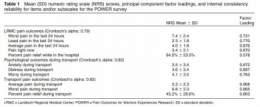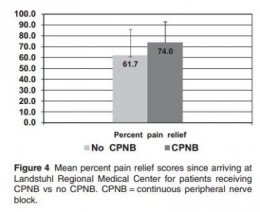La douleur: S'en occuper ACTIVEMENT
17/07/2013
Pain Following Battlefield Injury and Evacuation: A Survey of 110 Casualties from the Wars in Iraq and Afghanistan
Buckenmaier III CC et All. Pain Med. 2009 Nov;10(8):1487-96.
Objective. Advances in regional anesthesia, specifically continuous peripheral nerve blocks (CPNBs), have greatly improved pain outcomes for wounded soldiers in Iraq and Afghanistan. Painmanagement practice variations, however, do exist, depending on the availability of pain-trained military professionals deployed to combat support hospitals. An exploratory study was undertaken to examine pain and other outcomes during evacuation and at Landstuhl Regional Medical Center (LRMC), Germany.
Design. A mixed-methods, semistructured interview survey design was conducted on a convenience sample of wounded U.S. soldiers evacuated from Iraq and Afghanistan to LRMC. Setting and Patients. A total of 110 wounded soldiers evacuated from Iraq and Afghanistan from July 2007 to February 2008 completed a pain survey at LRMC. Data were collected on demographics, injury mechanism, last 24-hour average, least, and worst, and pain now by using a 0–10 scale, and percent pain relief (from 0% [No relief] to 100% [Complete relief]). Similar items and measures of anxiety, distress, and worry during flight transport were measured (from 0 [None] to 10 [Extreme]). Responses were analyzed by using descriptive and correlational statistics, multiple linear regression, Mann–Whitney U-tests, and t-tests. The Walter Reed Army Medical Center, Human Use Committee approved this investigation.
Results. Participants were typically male (99.1%), Caucasian (80%), and injured from improvised explosive devices (60%) and gunshots (21.8%). Average and worst pain scores were inversely correlated with pain relief during transport (r = -0.58 and r = -0.46, respectively; P < 0.001), and low to moderately positively correlated with increased anxiety, distress, and worry during transport (P < 0.05).
Average percent pain relief achieved was 45.2% 26.6% during transport and 64.5% 23.5% while at LRMC (P < 0.001).
Participants with CPNB catheters placed at LRMC reported significantlyy less pain right now (P = 0.031) and better pain relief (P = 0.029) than soldiers without CPNBs
Conclusions. Our findings underscore the value of early aggressive pain management after major combat injuries. Increased pain was associated with increased anxiety, distress, and worry during transport, suggesting the need for psychological management along with analgesia. Regional anesthesia techniques while at LRMC contributed to better pain outcomes





Les commentaires sont fermés.